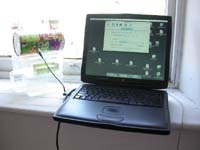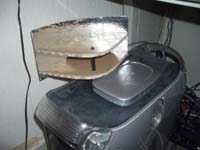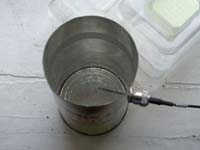The goal of this project was to establish a wireless network connection between Gertrude Contemporary Art Space and CLUBSproject inc. which would provide internet access for the CLUBS event mMa.
I started with a G3 powerbook (Wallstreet) and a Skynet Global WiFi card (thanks to Jophes). I decided that these would form the CLUBS side of the link. For the Gertrude side I used a wireless router, hoping this would be a set-and-forget type solution. The choice of router was based on price, availability and future usefulness. As the mMa is a three week project I wanted an access point that would provide for possible future uses, the Netgear WGR614 wireless router with its 4-port switcher and 11g compatibility (although not used for this project) seemed like a good choice for AU$130.
My first step was getting the PCMCIA card to work with the Powerbook. I used Mac OS 10.2.7 and the open source “WirelessDriver” available at sourceforge.net. After downloading and installing the WirelessDriver package I shutdown the powerbook, inserted the WiFi card and restarted. The card was recognised right away with the network pane in System Preferences showing a new network connection. I set this to “Using DHCP” and once I’d switched on the access point (it’s default setup is DHCP server) the powerbook automatically established a wireless network connection. The wirelessDriver package also installs a new pane in System Preferences called WirelessConfig. This pane lets you set the name of the access point you want to connect too and gives an indication of signal strength. The wirelessDriver team have done a great job with this package, the powerbook ran for three weeks straight without a hitch.
Setting up the wireless router was almost as easy. I connected the Netgears “internet port” to a spare LAN port on one of Gertrude’s existing routers and then (using the wireless connection from three feet away) I http’d the routers setup page and set it’s IP address and subnet mask (Gertrude’s network uses manual IP assigning). The wireless router was now on Gertrude’s network and sharing their internet connection with my PowerBook. While on the Netgears setup page I added my PowerBooks MAC address and turned on MAC filtering, blocking all wireless access except the PowerBooks. The connection was now working and secure, time to check the wireless coverage.
Gertrude and CLUBS are on opposite sides of Gertrude St. Fitzroy and only about 100m apart, but although there is a clear line of sight between the two locations Gertrude’s existing computer network is located in the offices at the back of the building. This places a very old and thick wall (possibly 4 layers of brick!) between the two wireless points, it was clear that the signal was going to need some help. There are a lot of good open-source antenna designs on the internet, ranging from ludicrously simple to stunningly complex. After a lot of internet browsing I decided on the ludicrously simple approach and choose to build a parabolic reflector for the wireless router and a Cantenna for the PowerBook.
The parabolic reflector is based on Michael Erkine’s designs. I chose this option when I discovered that the Netgear’s antenna is soldered directly onto the motherboard. Having just purchased the router I didn’t feel like immediately attacking it with a soldering iron and Michael makes a good point when he says “this antenna is so easy to make and performs so well that it is foolish not to try one”.
The reflector is designed to focus signals arriving at the front of the reflector onto the routers existing aerial and concentrate outgoing signals back along the same path. It will change the coverage pattern of your wireless router making it directional rather than omnidirectional. The reflector is placed over the routers existing aerial; the wireless router itself does not need to be dismantled or modified in any way. To build the reflector all you need is some cardboard, aluminium foil and glue, it took me about 15 minutes to build.
With the parabolic reflector installed at Gertrude I now had wireless coverage across the street but not as far as CLUBS, so I started making the Cantenna. I built my Cantenna on information from Gregory Rehm’s webpage. This is a great page with lots of invaluable info. The Cantenna is a little more difficult to build than the reflector, you need more than cardboard and tinfoil (but not much more). The most expensive part of the Cantenna is the connector that joins the can to the wireless network card. This is called a pigtail, you need to get one with the appropriate plug or socket that matches your particular wireless card – the plug on the can end of the pigtail is not so crucial. You will also need about 3.5cm of 2mm diameter (12 gauge) copper wire and a steel can. Gregory has a can size calculator on his webpage that will give you the optimum length for any given diameter of can. After a trip to the Milk-bar with a ruler I decided on a 850mL Golden Circle Pineapple & Orange Fruit Drink can, it had a good length to diameter ratio. Following Gregory’s instructions I put the Cantenna together in about half an hour (including time to drink the juice).
With the Cantenna sitting in the CLUBS window, pointed at Gertrude and plugged into my wireless network card I was able to get a strong network signal (WirelessConfig showed a signal strength of approx. -72dB). I turned on internet sharing in the powerbooks System Preferences and ran an ethernet cable from it’s built-in ethernet port to an iMac in the CLUBS project space (neither of these Macs have auto-sensing ethernet ports so I had to make a crossover cable for this). The iMac now had an active internet connection. I installed the open source and very cool Firefox internet browser and the project was complete.
The only problem I had with the system was that the Netgear wireless router would loose it’s network connection and needed to be reset every couple of days (turning it off and on usually did the trick, but because the router was over in Gertrude this got quite annoying) – (Note: I have since downloaded a firmware update for the router from Netgear and this problem seems to have disappeared).
This project would have been impossible without sites like Michael and Gregory’s, my thanks to them. Also, thanks to Gertrude Contemporary Art Space for sharing their broadband connection and Jophes for hardware and technical assistance.
Download a copy of the mMa Wireless Networking catalogue page here (193 KB PDF).


